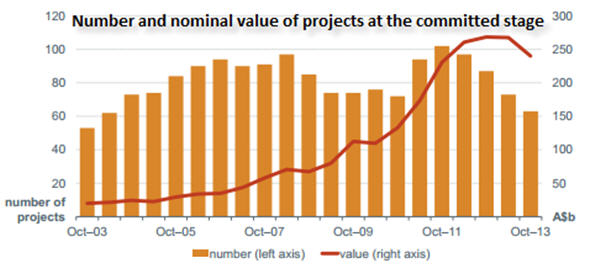Australia’s mining boom is over

It appears as though Australia’s decade-long mining boom is truly over.
New figures released Wednesday by the Bureau of Resources and Energy Economics (BREE) show that investment in the country’s mining industry has declined in the six months leading to October 2013.
Compared with the six months prior, the number of ‘committed stage’ projects dropped by 10 and the value of these projects declined by 10% to a combined A$240 billion. ‘Committed stage’ describes projects that have completed all permitting procedures and are either under construction or about to begin construction.
The drop in mining activity was also reflected in earlier-stage projects, with 12 fewer potential mines in the feasibility stage than at the end of April 2012 – a value drop of $24 billion.
Researchers identified two key drivers behind the decline. For one, the six-month period set a record for the value of projects moving into the ‘completion’ phase: $30 billion. Meanwhile, the country also recorded the lowest value of new projects being sanctioned in the past decade: $1.7 billion.
During the boom, Australia’s mining sector saw a massive influx of investment cash. Fuelled by rising commodity prices, the country became host to some ‘mega mining’ projects – those valued in excess of $5 billion. Mega-mines accounted for more than 50% of the total value of investment over the boom phase, according to the report.

Chart from BREE report
But the inevitable result of commodity price cycles is that surges in production eventually lead to price drops. This, combined with the fact that some projects are being delayed, has also precipitated the contraction of Australia’s resource boom.
Now the country is seeing a transition from the investment phase to the production phase and this transition is “only just the beginning,” the report reads.
“The economic benefits of the production phase may not be as large as the investment phase per year, but they are expected to last for considerably longer.”
Deputy executive director of BREE Wayne Calder remains optimistic, stressing that the projects completed over the next decade will “support strong commodity export volumes into the future.”
But with the current state of commodity prices, BREE warns that the industry is “unlikely” to see a rebound to the very high price levels observed during the peak of the latest cycle.
“As such, the prospects for investment at levels comparable to the past five years in Australia are limited,” the report reads.
{{ commodity.name }}
{{ post.title }}
{{ post.date }}

4 Comments
Greg Reid
Obviously the reduction in investment has affected the quality of PPE!
Rowan Weber
Does anybody see a direct correlation in the drop of investments in new mining ventures with the introduction of the carbon + mining taxes? I wonder!!!!!
José Cabello
Mining is not only the development or constructions stages .
More over the production stage is the most important regarding profit .
Therefore is not correct to say the “mining boom ” is over.
Rob Mulholland
Not so, a boom is defined as an increase in economic activity on by a demand. The demand has now been met (with the increased number of mines) and so the boom is over. The mining industry is bigger and more productive because of the boom, but there will be a steady production period for some years until demand rises again to create a new boom.